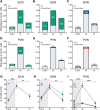Birth elicits a conserved neuroendocrine response with implications for perinatal osmoregulation and neuronal cell death
- PMID: 33504846
- PMCID: PMC7840942
- DOI: 10.1038/s41598-021-81511-1
Birth elicits a conserved neuroendocrine response with implications for perinatal osmoregulation and neuronal cell death
Abstract
Long-standing clinical findings report a dramatic surge of vasopressin in umbilical cord blood of the human neonate, but the neural underpinnings and function(s) of this phenomenon remain obscure. We studied neural activation in perinatal mice and rats, and found that birth triggers activation of the suprachiasmatic, supraoptic, and paraventricular nuclei of the hypothalamus. This was seen whether mice were born vaginally or via Cesarean section (C-section), and when birth timing was experimentally manipulated. Neuronal phenotyping showed that the activated neurons were predominantly vasopressinergic, and vasopressin mRNA increased fivefold in the hypothalamus during the 2-3 days before birth. Copeptin, a surrogate marker of vasopressin, was elevated 30-to 50-fold in plasma of perinatal mice, with higher levels after a vaginal than a C-section birth. We also found an acute decrease in plasma osmolality after a vaginal, but not C-section birth, suggesting that the difference in vasopressin release between birth modes is functionally meaningful. When vasopressin was administered centrally to newborns, we found an ~ 50% reduction in neuronal cell death in specific brain areas. Collectively, our results identify a conserved neuroendocrine response to birth that is sensitive to birth mode, and influences peripheral physiology and neurodevelopment.
Conflict of interest statement
The authors declare no competing interests. All data needed to evaluate the conclusions of this paper are present in the Results and Supplementary Material sections. Additional data related to this paper may be requested from the authors.
Figures







References
Publication types
MeSH terms
Substances
Grants and funding
LinkOut - more resources
Full Text Sources
Other Literature Sources
Molecular Biology Databases

